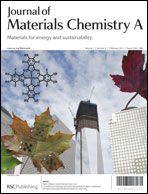Great attention has been paid to the development of mesoporous solid superbases due to their versatile catalytic activity under mild conditions. In this paper, a dualcoating strategy was designed to generate superbasicity on mesoporous silica SBA-15 by precoating ZrO2 prior to the loading of base precursor (KNO3). The ZrO2 interlayer performs two functions by enhancing the guest–host interactions to promote the decomposition of KNO3 at low temperatures, and by improving the alkali-resistance of the siliceous host, which simultaneously overcomes two weaknesses of mesoporous silicas. As a result, new dualcoating composites possessing both an ordered mesostructure and superbasicity were successfully fabricated. However, direct modification of SBA-15 with KNO3 results in a sample with only weak basicity and a collapsed mesostructure. Interestingly, both the amount and dispersion degree of ZrO2 play an important role in the generation of strong basicity. An intact layer can be formed on SBA-15 provided that the content of ZrO2 is higher than 30 wt% and the ammonia/water-induced hydrolysis (AIH) method is employed. The mesostructure cannot be preserved if the content of ZrO2 is lower than 30 wt% or if conventional coating methods (i.e. impregnation and grinding) are used. The obtained materials containing ZrO2 are active in heterogeneous synthesis of dimethyl carbonate (DMC) and the yield of DMC can reach 28.4%, which is obviously higher than that over the material without a ZrO2 coating (9.8%). The present strategy may open a new way for the design and synthesis of functional materials with strong basicity.

You have access to this article
 Please wait while we load your content...
Something went wrong. Try again?
Please wait while we load your content...
Something went wrong. Try again?


 Please wait while we load your content...
Please wait while we load your content...